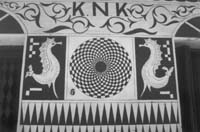
It's called Ksistá .
A decorative geometric pattern that covers the houses, and other
buildings, in Pirgi.
|
Pirgi - covered in ksistá.
Pirgi is one of the mastic villages in the south of Chios, a
Greek island just off the western coast of Turkey.
Chios is spelt in various ways including Hios and Xios. The
island is steeped in history and has largely resisted the tourist
push, perhaps because it is one of the more far flung islands of
Greece.
The island is famous for its mastic production.
The mastic bush is a stunted tree that produces an aromatic
gum.
This resin has been in much demand for centuries.
The substance has formed the base of paints, cosmetics, and not
the least the chewable jelly beans that were popular in the
Turkish harems. Now mastic is a bit of a novelty, its value
lessened by manufactured alternatives, so the monopoly that was
originally established by the Genoese in the 14th century, is no
longer of great value.
Mastic is still manufactured on the island and the process is
much the same as it has been for centuries. The resin is scraped
off the bark of the tree by local villagers who separate out the
leaves and twigs. It then goes to a central processing plant
where it is washed and baked. Around 150 tons are produced each
year and France, Bulgaria and Saudi Arabia are the main
buyers.
The mastic village of Pirgi is made all the more unique because
of the ksistá on the buildings.
When you walk into the village it almost demands a double-take,
the black and whiteness of it all is weird.
The ksistá is formed by cutting geometric patterns into
the plaster that covers the outside of the buildings, and then
these shapes are outlined in paint.
On your travels through Turkey and Greece, you may see the
occasional house decorated in ksistá - but Pirgi is the
mother village that dispenses ksistá to the world.
More
photos
|
